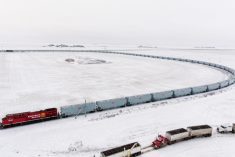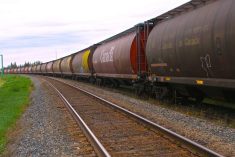CNS Canada — Canadian Pacific Railway managed to slightly increase its grain shipping volumes last year, despite the extreme cold.
CP moved 25.8 million tonnes of western Canadian grain, grain products, soybeans and non-regulated principal field crops during the 2017-18 crop year. That’s a one per cent increase from the previous crop year and one percent greater than CP’s three-year average.
Canadian National Railway shipped four per cent less in 2017-18 than it did in the previous year, with 24 million tonnes carried.
Higher-than-expected yields and cold weather caused grain backlogs in the early part of 2018. Cold weather forces the railways to run shorter trains.
Read Also

AAFC makes few changes to November S/D report
Agriculture and Agri-Food Canada made only a handful of alterations for its November report on principal field crops. The only changes AAFC made were with all wheat and durum exports plus domestic use for all wheat and corn in the estimates released on Nov. 24. The report had been initially scheduled for Nov. 19, but AAFC said they chose to delay it until after the United States Department of Agriculture issued its November supply and demand estimates following the U.S. government shutdown.
The railways are under increased scrutiny this year following the federal government’s passing of the Transportation Modernization Act earlier this year. The Act contains provisions to allow long-haul interswitching, requires railways to file winter grain movement reports and changes maximum revenue entitlements (MRE), a pricing structure that sets out what railways can charge to ship grain.
Another aspect of the Act which will impose financial penalties on railways for failing to deliver on promised service will take a year before a process can be established to hear complaints and administer rulings.
Neither railway responded to interview requests in time for this story.
In a report to federal Transport Minister Marc Garneau, CP published its plan for the upcoming shipping season. It expected the western Canadian crop to come in at 70.8 million tonnes. With carry-over stocks from the 2017-18 crop year, the system will move about 83.4 million tonnes this marketing year, said CP. That is five per cent larger than the previous five-year average.
Those estimates can vary wildly once the harvest starts to come off, CP’s document stated. Last year’s crop was originally estimated at 65 million tonnes, but ended up at about 71 million, a difference of almost 10 per cent.
“Our agricultural shippers have needs that are unique within our book of business, and we believe an ongoing dialogue with those companies is essential to understanding and meeting their needs,” Joan Hardy, CP’s vice-president of sales and marketing for grain and fertilizers, said in a news release. “Our plans for moving this year’s crop reflect that.”
CP said it plans to supply 5,500 hopper cars each week to meet grain-shipping requirements through autumn, until the Port of Thunder Bay closes for the season. After that it is aiming to supply 4,000 cars per week.
CP said it has more than 700 employees that are currently being trained and it expects to have more than 100 remodeled locomotives added to its fleet by the end of summer.
CP added it planned to spend in excess of $1.55 billion to replace track assets and upgrade its network.
Both railways said changes to the MRE enabled them to invest more into their grain-handling assets.
CN said it planned to have 1,000 new hopper cars in place over the next two years, 200 new locomotives over three years and about 1,200 new locomotive conductors. It also embarked on a $3.5 billion capital spending plan.
— Terry Fries writes for Commodity News Service Canada, a Glacier FarmMedia company specializing in grain and commodity market reporting.
















